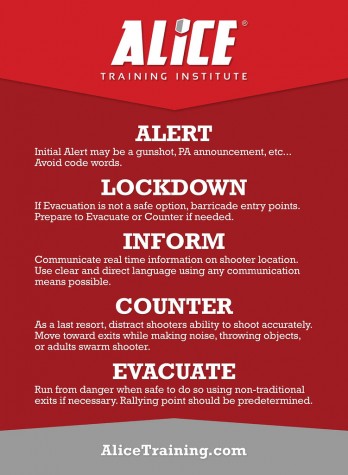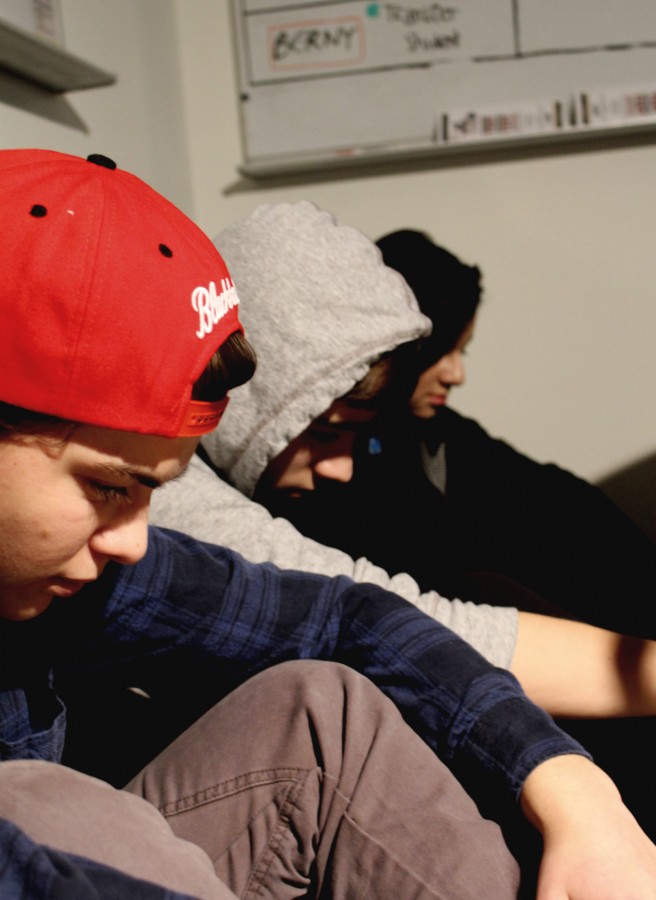DHS introducing major changes to lockdown procedure
New procedures will give options to alert, lockdown, inform, counter or evacuate, some teachers raise questions of security and liability
Twenty six lives were tragically lost in Newtown, Connecticut in Sandy Hook Elementary School on December 14th, 2012, after a man brought four loaded weapons inside the school. This heartbreaking event ended up being one of the most deadly school shootings in recent years. After the shooter targeted staff, he mercilessly went after 20 first-grade students, ending their lives and leaving their families devastated. After witnessing such a tragedy, as well as the additional 460 deaths and 366 casualties from mass shootings since 2000, schools felt compelled to create and revise their plans to keep students and faculty safe in the event of an active threat.
Deerfield High School is currently undergoing additions to its own lockdown procedures, working with both the Deerfield Police Department and the ALICE Training Institute, an organization that has created a set of procedures for active threat situations and trains districts and schools to perform them. The procedures, from which ALICE Training Institute took its name, can be simplified into the acronym, “ALICE,” which stands for “Alert, Lockdown, Inform, Counter, Evacuate”, each of these being an option which a teacher can employ during an active threat situation. Reaction from DHS faculty varies, with some vocal opposition from several faculty members.
Under these new procedures, once the announcement of an active threat is made over the PA system eg. “There is an active threat in R-hall”, teachers will have the ability to respond with any one or more of these options. These choices given to the teachers are a significant departure from previous active threat procedures, which instructed both teachers and students only to stay out of sight from any windows, completely silent, with the door locked. These procedures are still suitable for teachers to follow, included in ALICE as “Lockdown”, but they are no longer the only course of action.
The decision to introduce new lockdown procedures was initiated by the Township High School District 113 offices, who declined to discuss the cause of the transition to ALICE beyond the following written statement from the Director of Communications and Alumni Relations, Jennifer Waldorf:
“The District passed along information regarding an upcoming ALICE program to the security managers at both buildings and paid for both Security Resource Officers to attend. Beyond that, implementation is taking place at the building level-and is also in very early stages-so there is not much to report from the District’s perspective at this time,” Waldorf said.
After the district notified Security Resource Officer Anthony Kropp, as well as Security Manager George Grubb and Dean Gail Gausselin about the ALICE procedures in the spring of 2015, they were sent to a two day training seminar by the ALICE Training Institute that summer, along with their counterparts at Highland Park High School. The training program utilized hands-on experience to explain ALICE, as described by Kropp.
“We had scenario based training, so they would put us in a class like we were students, and say ‘Here’s how we are going to run this scenario. This one, an intruder is going to come in and you are going to react.’ Then they would tell us ‘Barricade or fight back or do this’ so they walked us through what it felt like, and we would get shot with the plastic bullets … we got to really feel what it would be like to try every step of the ALICE program, and I think that really helped us realize it’s a good program,” Kropp said.
In early September, several optional meetings were held for staff that explained the new procedures, but did not reference the ALICE program directly. DHS science teacher John Motzko shared his interpretation of these initial, optional meetings.
“They explained some procedures in regards to lockdowns, and in regard to statistics. What kind of surprised me was that, [later] there was a mandatory meeting that they had where they were explaining what essentially was the same thing, but now it had this acronym attached to it, this ALICE aspect,” Motzko said.
These mandatory meetings took place just short of two months after the original meetings, in early November. All staff members were required to attend at least one of a series of meetings, where ALICE was officially announced and explained to all faculty. Carly Micheles of the P.E. Department described the information portrayed at the meeting.
“Basically, they just said that it’s pretty much the same except you have the opportunity to make decisions on what you want to do based on where the threat is in the school, so you have a broader range of different things that you can do to protect yourself,” Micheles said.

At both of these meetings, several teachers raised questions and concerns about the new procedures. The introduction of subjective decision making leads to several potential issues that these teachers are worried about, one of which is the sheer uncertainty of being forced into making a decision in an active threat situation. Brian Forrester, an English teacher at DHS, talked about the fear of potentially unknown problems occurring because of a miscalculated decision taken using the new procedures, an outcome that would not have been able to take place had with the previous, uniform procedures.
“You really have to rely on the accuracy of the announcement that is made. So if say, I’m in X-hall with my homeroom and they say the threat is in R-hall, you really are putting your trust in that that is right, and if I make the decision, ‘Okay R-hall, that’s far away, we’re in X-hall, we’re going to get out of here’, and maybe the threat is more pervasive than I thought, then we may be walking into some trouble,” Forrester said.
Forrester is not the only teacher who feels this way, as science teacher John Motzko, echoed this concern. Motzko expressed his fears about situations in which students are in danger after they have evaded the shooter and have left the building.
“What happens if I take them off school grounds and if they are injured from something totally unrelated to the shooting? My biggest concern is there are people driving out there in all those subdivisions, somebody comes around the corner not expecting a crowd of 500 kids to be making their way towards some direction, and they plow into a crowd. They aren’t expecting to see that, and if it is a chaotic situation, and there is actually a shooter there, I would imagine people are going to be freaked out and trying to run every possible direction,” Motzko said.
Beyond these situations, former courtroom lawyer Jerold Lavin, now a DHS Social Studies teacher, also worries about the consequences of potentially disparate reactions from teachers. The uniformity of the old procedures ensures all students were accounted for. Now, within a single hallway, some teachers could be taking their classes out of the building, while others remain in their classrooms. He feels that, if teachers don’t act in unison during an active shooter situation, the resulting confusion adds more danger than it removes.
“If I’m recalling this correctly, somebody [at the training meeting] referred to this as potentially ‘chaotic’, and I believe the speaker said, ‘Well it’s going to be chaos anyway, because that’s the way these things are’ … In my opinion, if it’s going to be chaos anyway, why add to the chaos?” Lavin said.
Officer Kropp feels differently, saying that the addition of options does not add stress, and that different reactions from teachers are the goal of implementing ALICE, so that aspect should not be cause for concern.
“There won’t be any consequences. We aren’t telling people what to do, we are only giving them the options to choose what they want to do now. If they chose to stay and think they are safer in lockdown, but another teacher says ‘We’re getting out,’ that’s okay. That’s exactly what we actually want, for teachers to make their own decisions. Nobody is going to have any consequences. There is no right way, there is no perfect way or perfect solutions to these scenarios,” Kropp said.
Furthermore, Lavin, Forrester, and Motzko all expressed uncertainty regarding what may happen after a potential attack in terms of liability. As a former lawyer, Lavin is unsure whether the relevant Illinois statute, the Good Samaritan statute, which protects any sort of trained aid from liability in the event that the subject of their aid dies under their care, would actually protect a teacher from the consequences of the worst case scenario of the ALICE procedures.
“To what extent, if at all, can a staff member be held liable for their subjective determination to ‘counter the attacker’ or ‘evacuate or get out’, with respect to the consequences of those choices?” asked Lavin. “It seems to me that, if the response from the District is, ‘Don’t worry good teacher, we have the Illinois Good Samaritan law,’ then, okay, that’s fine, if that’s the case … then the School District has nothing to worry about indemnifying me and my colleagues, because there’s the Good Samaritan law … if I’m protected because of the Illinois law, then the District is protected too,” Lavin said.
DHS Principal Christopher Dignam commented on the concerns regarding liability for events taken place of beyond the school campus. While he did not have an answer to Lavin’s question about the Good Samaritan Statute, he did provide some information as to what protection is out there for teachers.
“The reality is that anyone can sue anyone for anything that they like, but the District office does have liability insurance, so it would be the same thing if you’re on a field trip and someone gets sick, and you have to deal with that and what you do with that situation, or if you take students out of the country on a trip and you’re a chaperone,” Dignam said.
Although some teachers have expressed their concerns, not all teachers have issues with the ALICE procedures. Micheles expressed that much of the faculty appreciates the change, saying that the flexibility that ALICE provides teachers makes them more comfortable.
“I understand the need to have everyone in one spot, so we have everyone accounted for … but if we are in an area where there is no threat, I don’t see why people should be sitting ducks in their own classroom, where the threat can possibly move to them, and they could have actually gotten away,” Micheles said.
Overall, Motzko and Lavin recognize that the changes come from good intentions, in the best interest of trying to keep our school safe, but the issues that the new procedures present are equally pressing.
“I don’t think they are just pulling at straws, saying ‘let’s try this new thing.’ But like anything, you go under a new procedure, you go under a new philosophy, there’s questions that do need to be answered, and I’m not sure we are quite to the satisfaction of having all those things answered yet,” said Motzko.
“Ultimately, my takeaway from this, is that my sense, my opinion, is that what’s trying to be said is ‘use common sense’. That’s very difficult to write down … because what is common sense to you may not be common sense to me, and we could be in the same hallway. What’s common sense in one hallway may not be common sense to me, because the sense is not common. That, therein, presents the problem,” said Lavin.
As of publishing this article, there has been no formal communication regarding the implementation of ALICE in Deerfield’s lockdown procedures to students. Officer Kropp stated the security office plans on having the new options integrated into the standard procedures by the beginning of the 2016-2017 school year, and by that time, all staff will be trained. Based on limited polling, almost no students are aware of any sort of change in lockdown procedures, while a majority of staff believe the new procedures to be currently in place.

Sakina Naqvi, a junior here at DHS, is a second-year writer for Deerprints. With a passion for journalism, Sakina is excited to explore her talents in...






